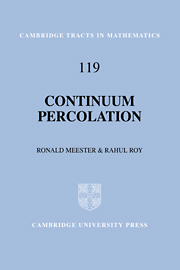Refine search
Actions for selected content:
3023 results in Probability theory and stochastic processes
PART III - MALLIAVIN CALCULUS
-
- Book:
- Malliavin Calculus for Lévy Processes and Infinite-Dimensional Brownian Motion
- Published online:
- 05 March 2012
- Print publication:
- 01 March 2012, pp 289-290
-
- Chapter
- Export citation
Appendix A - Poly-saturated models
- from APPENDICES: EXISTENCE OF POLY-SATURATED MODELS
-
- Book:
- Malliavin Calculus for Lévy Processes and Infinite-Dimensional Brownian Motion
- Published online:
- 05 March 2012
- Print publication:
- 01 March 2012, pp 379-387
-
- Chapter
- Export citation
Introduction
- from PART II - AN INTRODUCTION TO FINITE- AND INFINITE-DIMENSIONAL STOCHASTIC ANALYSIS
-
- Book:
- Malliavin Calculus for Lévy Processes and Infinite-Dimensional Brownian Motion
- Published online:
- 05 March 2012
- Print publication:
- 01 March 2012, pp 175-176
-
- Chapter
- Export citation
18 - The Malliavin derivative
- from PART III - MALLIAVIN CALCULUS
-
- Book:
- Malliavin Calculus for Lévy Processes and Infinite-Dimensional Brownian Motion
- Published online:
- 05 March 2012
- Print publication:
- 01 March 2012, pp 306-318
-
- Chapter
- Export citation
PART II - AN INTRODUCTION TO FINITE- AND INFINITE-DIMENSIONAL STOCHASTIC ANALYSIS
-
- Book:
- Malliavin Calculus for Lévy Processes and Infinite-Dimensional Brownian Motion
- Published online:
- 05 March 2012
- Print publication:
- 01 March 2012, pp 173-174
-
- Chapter
- Export citation
23 - Malliavin calculus for Lévy processes
- from PART III - MALLIAVIN CALCULUS
-
- Book:
- Malliavin Calculus for Lévy Processes and Infinite-Dimensional Brownian Motion
- Published online:
- 05 March 2012
- Print publication:
- 01 March 2012, pp 352-376
-
- Chapter
- Export citation
19 - The Skorokhod integral
- from PART III - MALLIAVIN CALCULUS
-
- Book:
- Malliavin Calculus for Lévy Processes and Infinite-Dimensional Brownian Motion
- Published online:
- 05 March 2012
- Print publication:
- 01 March 2012, pp 319-327
-
- Chapter
- Export citation
Preface
-
- Book:
- Malliavin Calculus for Lévy Processes and Infinite-Dimensional Brownian Motion
- Published online:
- 05 March 2012
- Print publication:
- 01 March 2012, pp xv-xx
-
- Chapter
- Export citation
15 - Lindstrøm's construction of standard Lévy processes from discrete ones
- from PART II - AN INTRODUCTION TO FINITE- AND INFINITE-DIMENSIONAL STOCHASTIC ANALYSIS
-
- Book:
- Malliavin Calculus for Lévy Processes and Infinite-Dimensional Brownian Motion
- Published online:
- 05 March 2012
- Print publication:
- 01 March 2012, pp 247-270
-
- Chapter
- Export citation
Contents
-
- Book:
- Malliavin Calculus for Lévy Processes and Infinite-Dimensional Brownian Motion
- Published online:
- 05 March 2012
- Print publication:
- 01 March 2012, pp vii-xiv
-
- Chapter
- Export citation
7 - Introduction to poly-saturated models of mathematics
- from PART I - THE FUNDAMENTAL PRINCIPLES
-
- Book:
- Malliavin Calculus for Lévy Processes and Infinite-Dimensional Brownian Motion
- Published online:
- 05 March 2012
- Print publication:
- 01 March 2012, pp 95-106
-
- Chapter
- Export citation
20 - The interplay between derivative and integral
- from PART III - MALLIAVIN CALCULUS
-
- Book:
- Malliavin Calculus for Lévy Processes and Infinite-Dimensional Brownian Motion
- Published online:
- 05 March 2012
- Print publication:
- 01 March 2012, pp 328-334
-
- Chapter
- Export citation
4 - Abstract Wiener–Fréchet spaces
- from PART I - THE FUNDAMENTAL PRINCIPLES
-
- Book:
- Malliavin Calculus for Lévy Processes and Infinite-Dimensional Brownian Motion
- Published online:
- 05 March 2012
- Print publication:
- 01 March 2012, pp 50-70
-
- Chapter
- Export citation
5 - Two concepts of no-anticipation in time
- from PART I - THE FUNDAMENTAL PRINCIPLES
-
- Book:
- Malliavin Calculus for Lévy Processes and Infinite-Dimensional Brownian Motion
- Published online:
- 05 March 2012
- Print publication:
- 01 March 2012, pp 71-81
-
- Chapter
- Export citation
13 - The iterated integral
- from PART II - AN INTRODUCTION TO FINITE- AND INFINITE-DIMENSIONAL STOCHASTIC ANALYSIS
-
- Book:
- Malliavin Calculus for Lévy Processes and Infinite-Dimensional Brownian Motion
- Published online:
- 05 March 2012
- Print publication:
- 01 March 2012, pp 211-228
-
- Chapter
- Export citation
Appendix B - The existence of poly-saturated models
- from APPENDICES: EXISTENCE OF POLY-SATURATED MODELS
-
- Book:
- Malliavin Calculus for Lévy Processes and Infinite-Dimensional Brownian Motion
- Published online:
- 05 March 2012
- Print publication:
- 01 March 2012, pp 388-397
-
- Chapter
- Export citation
3 - Fourier and Laplace transformations
- from PART I - THE FUNDAMENTAL PRINCIPLES
-
- Book:
- Malliavin Calculus for Lévy Processes and Infinite-Dimensional Brownian Motion
- Published online:
- 05 March 2012
- Print publication:
- 01 March 2012, pp 37-49
-
- Chapter
- Export citation

Continuum Percolation
-
- Published online:
- 05 November 2011
- Print publication:
- 13 June 1996

Topics in the Constructive Theory of Countable Markov Chains
-
- Published online:
- 05 November 2011
- Print publication:
- 18 May 1995

Introdction to Measure and Probability
-
- Published online:
- 05 November 2011
- Print publication:
- 01 January 1966
